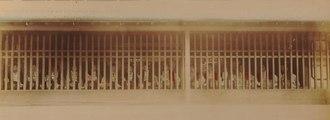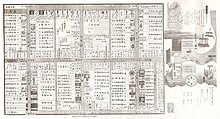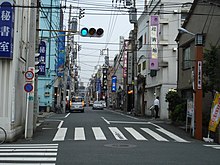Prostitution in Japan


Prostitution in Japan has existed throughout the
Sex trade and sex services may be referred to as fūzoku (風俗), which also means "manners", "customs" or "public morals".
Since Japanese law defines prostitution as "intercourse with an unspecified person in exchange for payment", most fūzoku services offer specifically non-coital services, such as conversation, dancing or bathing, sometimes accompanied by sexual acts that legally are not defined as "intercourse", in order to remain legal.[2]
History
From the 15th century, Chinese, Koreans, and other East Asian visitors frequented brothels in Japan.[3]
This practice later continued among visitors from "the Western regions", mainly European traders who often came with their South Asian lascar crew (in addition to African crew members in some cases).[4] This began with the arrival of Portuguese ships to Japan in the 1540s, when the local Japanese people assumed that the Portuguese were from Tenjiku (天竺, "Heavenly Abode"), the ancient Chinese name (and later Japanese name) for the Indian subcontinent, and thus assumed that Christianity was a new Indian religion. These mistaken assumptions were due to the Indian state of Goa being a central base for the Portuguese East India Company at the time, and due to a significant portion of the crew on Portuguese ships being Indian Christians.[5]
Hundreds of Japanese people, especially women, were sold as slaves.[6] Portuguese visitors and their South Asian and African crew members (or slaves) often engaged in slavery in Japan. They bought or captured young Japanese women and girls, who were either used as sexual slaves on their ships or taken to Macau and other Portuguese colonies in Southeast Asia, the Americas,[4] and India, where there was a community of Japanese slaves and traders in Goa by the early 17th century.[7] Anti-Portuguese propaganda and exaggerations were actively promoted by the Japanese, particularly with regards to the Portuguese purchases of Japanese women for sexual purposes.[8]
In 1505, syphilis started to appear in Japan, likely because of Japanese prostitutes having sex with Chinese sailors. In
Edo era

In 1617, the
Pleasure quarters were walled and guarded for taxation and access control.[10] Prostitutes and courtesans were licensed as yūjo (遊女, "women of pleasure") and ranked according to an elaborate hierarchy, with tayū and later oiran at the apex.[11] The women were not allowed outside of the walls except to visit dying relatives and, once a year, for hanami (viewing cherry blossoms).[10][13][14]
Prewar modern era
The
In 1908, the Ministry of Home Affairs' Ordinance No. 16 penalized unregulated prostitution.[19]
Karayuki-san
Karayuki-san was the name given to Japanese girls and women in the late 19th and early 20th centuries who were trafficked from poverty stricken agricultural prefectures in Japan to destinations in East Asia, Southeast Asia, Siberia (Russian Far East), Manchuria, and India to serve as prostitutes and sexually serviced men from a variety of races, including Chinese, Europeans, native Southeast Asians, and others.[20][21]
Postwar era
Immediately after
In 1947, Imperial Ordinance No. 9 punished persons for enticing women to act as prostitutes, but prostitution itself remained legal. Several bills were introduced in the Diet to add further legal penalties for soliciting prostitutes but were not passed due to disputes over the appropriate extent of punishment.
On 24 May 1956, the
In 2013,
Religious connotations
Shinto
The Shinto faith does not regard sex as a taboo.[26] During the Kamakura period, many shrines and temples, which provided for miko, fell into bankruptcy. Some miko started travelling in search of livelihood and came to be known as aruki miko (lit. 'walking miko'). While aruki miko primarily provided religious services, they were also widely associated with prostitution. However, no religious reasons for miko prostitution are known, and hence the act might be unrelated to sacred prostitution.[27]
Buddhism
Buddhist teachings regarding sex are quite reserved: "It is true to say that Buddhism, in keeping with the principle of the Middle Way, would advocate neither extreme puritanism nor extreme permissiveness."[28] Buddhism has rules and protocols for those that are to live the Buddhist principles in the monasteries and the secular part of the [Shanga]. For the Buddhist monks or nuns, chastity is mandatory since they live on the premise of getting rid of any feelings of attachment. Their way of living is regulated by very strict rules concerning behavior and this includes sex.[28][29]
As for the secular Buddhists, there are no specific rules to be followed about sex; although any kind of abuse is regarded as "misconduct".[30]
Current status
Legal status
Article 3 of the Prostitution Prevention Law (売春防止法, Baishun Bōshi Hō) of 1956[31] states that "No person may either do prostitution or become the customer of it", but no judicial penalty is defined for this act.[32] Instead, the following are prohibited on pain of penalty: soliciting for purposes of prostitution, procuring a person for prostitution, coercing a person into prostitution, receiving compensation from the prostitution of others, inducing a person to be a prostitute by paying an "advance", concluding a contract for making a person a prostitute, furnishing a place for prostitution, engaging in the business of making a person a prostitute, and the furnishing of funds for prostitution.[33]
The definition of prostitution is strictly limited to
The
Types

The sex industry in Japan uses a variety of names.
Tokyo is the business and trade center of Japan, and therefore also a thriving market for sex work of all varieties.
It was reported in 2003 that as many as 150,000 non-Japanese women were then involved in prostitution in Japan.
According to National Police Agency records, out of 224 non-Japanese people arrested for prostitution offences in 2018, 160 (71%) were mainland Chinese, 19 (8%) were Thai.[41]
Many businesses related to prostitution voluntarily (i.e., despite there being no regulation requiring it) ban entry to foreigners, including tourists, people who cannot speak Japanese, and even people who do not have Asian traits.[42] However, in recent years, several businesses have been set up to specifically cater to the foreigner market.
Terms
- Baishun (売春, "selling spring" or "selling youth")
- The act of selling sex. Originally a euphemism, it has become a legal term used in, for instance, the title of the 1956 Anti-Prostitution Law (売春防止法, Baishun-bōshi-hō); the modern meaning of the word is quite specific and it is usually only used for actual (i.e., illegal) prostitution. The word for "prostitute" in Japanese is baishunfu (売春婦).
- Kaishun (買春)
- The act of buying sex. The title of the law (Jidō-kaishun-shobatsu-hō (児童買春処罰法)) was used in 1999. The reading kaishun is yutō-yomi, and it is used because the alternative reading baishun would be easily confused with baishun.
- Baibaishun (売買春/買売春)
- A combination of baishun and kai/baishun; meaning "prostitution".
- Mizu shōbai (水商売)
- Literally the "water trade"; a wider term covering the entire entertainment industry. An older term originating in the pleasure quarters of the previous centuries, the mizu-shōbai referred to not only yūjo, but also their higher-class cousins the oiran, tayū, kabuki actors, and geisha; while the former three were legitimate in selling sex, the latter two did not do so officially, though some either chose to sell sex for money, or, in the case of the famous geisha Teruha, may have been coerced or even forced into it.
- Fūzoku (風俗)
- "Manners", also "customs" or "public morals"; commonly used to refer specifically to the sex industry, although in legal use this covers, e.g., dance halls and gambling, and the more specific term seifūzoku (性風俗), is used instead. The term originates from a law regulating business affecting public morals.[citation needed]
Sex trafficking
Japan is a destination, source, and transit country for men, women and children subjected to
Japanese citizens, particularly runaway teenage girls, are also subjected to sex trafficking. Enjo kōsai, or "compensated dating", and variants of the JK business continue to facilitate the sex trafficking of Japanese children. Highly organized prostitution networks target vulnerable Japanese women and girls—often living in poverty or with cognitive disabilities—in public spaces such as subways, popular youth hangouts, schools, and online, and subject them to sex trafficking. Private Japanese immigration brokers help Japanese-Filipino children and their Filipina mothers move to Japan and acquire citizenship for a significant fee, which the mothers often incur large debts to pay; upon arrival, some of these women and their children are subjected to sex trafficking to pay off the debts.[43]
As of 2020[update], the United States Department of State Office to Monitor and Combat Trafficking in Persons ranks Japan as a 'Tier 2' country.[44]
See also
- Akasen
- Comfort women serving in brothels of the Japanese military in World War II
- Gate of Flesh
- Geisha and prostitution
- Prostitution in Cambodia
- Prostitution in India
- Prostitution in Indonesia
- Prostitution in Thailand
- Prostitution in the Philippines
Notes
- ^ a b Hoffman, Michael (25 April 2007). "Japan's love affairs with sex". The Japan Times Online. Retrieved 20 December 2017.
- ^ Hongo, Jun (27 May 2008). "Law bends over backward to allow fuzoku". japantimes.co.jp. the japan times. Retrieved 1 June 2020.
- ^ a b Leupp 2003, p. 48.
- ^ a b Leupp 2003, p. 49.
- ^ Leupp 2003, p. 35.
- ^ Hoffman, Michael (26 May 2013). "The rarely, if ever, told story of Japanese sold as slaves by Portuguese traders". The Japan Times.
- ^ Leupp 2003, p. 52.
- ^ In the Name of God: The Making of Global Christianity By Edmondo F. Lupieri, James Hooten, Amanda Kunder [1]
- ^ Leupp 2003, p. 50.
- ^ ISBN 978-0313329685.
- ^ a b "Edo Pleasure Districts". Geisha of Japan. Retrieved 21 December 2017.
- ^ "Courtesans and the Licensed Pleasure Quarters in Edo Japan". Asian Art Education. Retrieved 21 December 2017.
- ISBN 978-0486455631.
- ISBN 978-0804847353.
- ISBN 0-7679-0490-7, page 97
- ^ Morisaki, Baishun ō koku no onnatachi.
- ^ Stanley 2012, p. 193.
- ^ Stanley 2012, p. 194.
- ISBN 978-0195385779.
- ^ 来源:人民网-国家人文历史 (10 July 2013). "日本性宽容:"南洋姐"输出数十万". Ta Kung Pao 大公报.
- S2CID 146273713.
- ^ Yuki Tanaka, Japan's Comfort Women: Sexual Slavery and Prostitution during World War II and the US Occupation, Asia's Transformations (NEW York: Routhledge, 2002)133-135.
- Hirohito and the making of modern Japan, 2001, p. 538, citing Kinkabara Samon and Takemae Eiji, Showashi: kokumin non naka no haran to gekido no hanseiki-zohoban, 1989, p. 244.
- ^ Slavin, Erik (14 May 2013). "Osaka mayor: 'Wild Marines' should consider using prostitutes". Stars and Stripes. Retrieved 19 May 2013.
- Japan Times. 17 May 2013. Retrieved 19 May 2013.
- ^ Velgus, Justin (9 November 2012). "Why Japanese People Are Comfortable With Nakedness". Gaijin Pot. Retrieved 10 December 2015.
While sexuality is not encouraged in most Western religions, Japan's native Shinto religion is more open-minded… Shinto and Buddhism, both practiced and often blended in Japanese beliefs, do not consider most forms of sexuality to be sacrilegious.
- doi:10.7202/007130ar. Retrieved 12 December 2017.
- ^ a b "Buddhism and Sex". Accesstoinsight.org. 16 June 2011. Retrieved 3 August 2012.
- ^ "The Rules for Buddhist Monks and Nuns" (PDF). Dhammaweb.net. Retrieved 24 October 2013.
- ^ "Sex and Buddhism - What Buddhism Teaches About Sex". Buddhism.about.com. Retrieved 3 August 2012.
- ^ For the name, see WWWJDIC (link Archived 3 January 2015 at the Wayback Machine).
- ^ a b "5: The definition of prostitution is applied to limited sex acts (e.g. Japan)". Sexuality, Poverty and Law. Retrieved 21 September 2018.
- Japan Times, 27 May 2011, p. 3.
- OCLC no.19432229.
- ^ Sanders 2006, p. 41.
- ^ Hartley, Ryan (Spring 2005). "The politics of dancing in Japan" (PDF). The Newsletter (70).
- ^ Sanders 2006, p. 28.
- ^ "The sex industry in Tokyo". Tokyo Ezine. Archived from the original on 22 December 2017. Retrieved 20 December 2017.
- ^ McNeill, David (11 November 2003). "Running the sex trade gantlet". Japan Times. Retrieved 20 December 2017.
- ^ "来日外国人犯罪の検挙状況(平成25年)【訂正版】" (PDF). National Police Agency. 24 October 2014. p. 44.
- ^ "平成30年における組織犯罪の情勢" (PDF). National Police Agency. 3 March 2019.
- ^
Joan Sinclair (2006). Pink Box: Inside Japan's Sex Clubs. Harry N. Abrams. ISBN 9780810992597. Retrieved 5 January 2009.
- ^ a b "Japan 2018 Trafficking in Persons Report". U.S. Department of State. Archived from the original on 10 July 2018. Retrieved 28 July 2018.
 This article incorporates text from this source, which is in the public domain.
This article incorporates text from this source, which is in the public domain.
- ^ "2020 Trafficking in Persons Report: Japan". U.S. Department of State. Retrieved 15 May 2021.
References
- Leupp, Gary P. (2003). Interracial Intimacy in Japan: Western Men and Japanese Women, 1543–1900. ISBN 978-0-8264-6074-5.
- Sanders, Holly (2006). "Indentured Servitude and the Abolition of Prostitution in Postwar Japan" (PDF). Cambridge, Mass.: Program on U.S.-Japan Relations, Harvard University. Archived from the original (PDF) on 21 November 2011.
- Stanley, Amy (2012). Selling Women: Prostitution, Markets, and the Household in Early Modern Japan (1 ed.). University of California Press. pp. 193, 194. JSTOR 10.1525/j.ctt1pnm4q.
Further reading
- ISBN 3-8228-8189-9. 768 pages. Black and white photographs of Shinjukusex workers, clients, and businesses taken 1983–5.
- Associated Press. "Women turn to selling sexual favors in Japan" (archived copy). Taipei Times, 9 December 2002, p. 11. Accessed 11 October 2006.
- Bornoff, Nicholas. Pink Samurai: Love, Marriage and Sex in Contemporary Japan. New York: Pocket Books, 1991. ISBN 0-671-74265-5.
- Clements, Steven Langhorne. Tokyo Pink Guide. Tokyo: Yenbooks, 1993. ISBN 0-8048-1915-7.
- Constantine, Peter. Japan's Sex Trade: A Journey Through Japan's Erotic Subcultures. Tokyo: Yenbooks, 1993. ISBN 4-900737-00-3.
- De Becker, J. E. The Nightless City ... or, The "History of the Yoshiwara Yūkwaku"., 4th ed. rev. Yokohama [etc.] M. Nössler & Co.; London, Probsthain & Co., 1905. ISBN 1-933330-38-4.
- De Becker, J. E. The Nightless City: Geisha and Courtesan Life in Old Tokyo (reprint). Mineola, N.Y.: Dover Publications, 2007. ISBN 0-486-45563-7.
- De Mente, Boye Lafayette. Mizu Shobai: The Pleasure Girls and Flesh Pots of Japan. London: Ortolan Press, 1966.
- De Mente, Boye Lafayette. Sex and the Japanese: The Sensual Side of Japan. Rutland, Vermont: Tuttle Publishing, 2006. ISBN 0-8048-3826-7.
- De Mente, Boye Lafayette. Tadahito Nadamoto (illus.). Some Prefer Geisha: The Lively Art of Mistress Keeping in Japan. Rutland, Vermont: Charles E. Tuttle Co., 1966.
- Fitzpatrick, William. Tokyo After Dark. New York: McFadden Books, 1965.
- French, Howard W. "Japan's Red Light 'Scouts' and Their Gullible Discoveries". The New York Times. 15 November 2001. Accessed 11 October 2006.
- Goodwin, Janet R. Selling Songs and Smiles: The Sex Trade in Heian and Kamakura Japan. Honolulu: University of Hawai’i Press, 2007. ISBN 0-8248-3097-0.
- Japan The Trafficking of Women.
- Kamiyama, Masuo. "The day Japan's red lights flickered out". MSN-Mainichi Daily News. 25 February 2006. Accessed 11 October 2006.
- Kattoulas, Velisarios. "Human Trafficking: Bright Lights, Brutal Life" (archived copy). Far East Economic Review. 3 August 2000. Accessed 11 October 2006.
- Longstreet, Stephen, and Ethel Longstreet. Yoshiwara: City of the Senses. New York: McKay, 1970.
- McMurtrie, Douglas C. Ancient Prostitution in Japan. Whitefish, Montana: Kessinger Publishing, 2005. ISBN 0-7661-4115-2.
- Seigle, Cecilia Segawa. Yoshiwara: The Glittering World of ihe Japanese Courtesan. Honolulu: University of Hawaii Press, 1993. ISBN 0-8248-1488-6.
- The World's Oldest Debate? Prostitution and the State in Imperial Japan, 1900–1945
- Talmadge, Eric. Getting Wet: Adventures in the Japanese Bath. Tokyo ; New York: Kodansha International, 2006. ISBN 4-7700-3020-7.
- Yokoyama, M. "Analysis of Prostitution in Japan". International Journal of Comparative and Applied Criminal Justice, 19, no. 1 (1995): 47–60.
- Yokoyama, M. "Emergence of Anti-Prostitution Law in Japan—Analysis from Sociology of Criminal Law". International Journal of Comparative and Applied Criminal Justice, 17, no. 2 (1993): 211–218.
External links
- Coalition Against Trafficking in Women-Asia Pacific Facts and Statistics Trafficking and Prostitution in Asia and the Pacific, See under Japan category. Accessed online 27 September 2007.
- Sex Industry category, Japan Subculture Research Center—a news blog on "the hidden side of Japan".
- Fact-book on global sexual exploitation
- Global March Statistics
